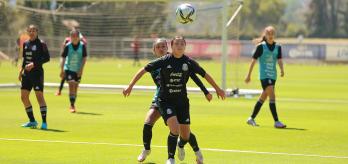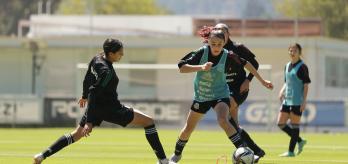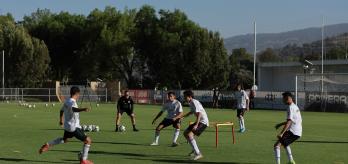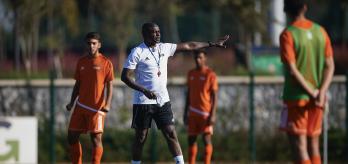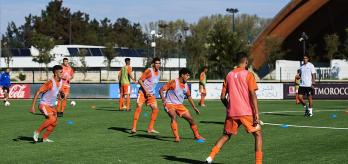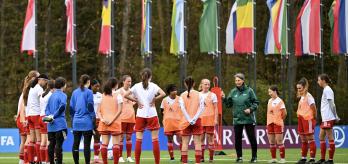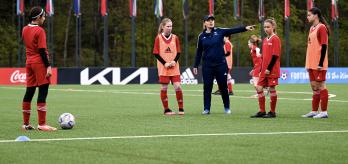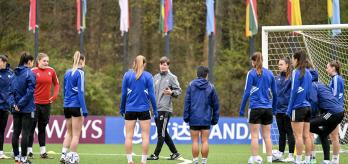A successful back four must be capable of moving as a unit, remaining compact, maintaining good distances between its constituent parts and communicating effectively. Furthermore, the players must be aware of their positioning, both individually and as a group, so as to prevent the opposition from picking holes in the backline. This session aims to provide the back four with all of the necessary tools to perform effectively when faced with a range of challenging scenarios.
In this session, former Arsenal goalkeeper and assistant coach, Jens Lehmann, works with a group of girls and introduces a set of exercises aimed at helping them to lay the foundations of a functional back four. The session starts with a 6v5 exercise that focuses on defending wide spaces. The second drill, which features a 6v4 (attack v. defence) exercise played on one half of the pitch, sees the defending team face a greater challenge. The session is rounded off with a 7v6 (attack v. defence) drill in which the attacking team set up in a 5-2 formation and the defending team adopt a 4-2 formation.
Session overview
Key coaching points
-
The defensive line should shuffle across the pitch quickly, whilst players should maintain a distance of 6-8 metres between one another so as to ensure that opposing players are unable to find spaces.
-
The backline must stay compact and force the opposition into playing around, rather than through, central areas.
-
The defenders should look for triggers to push the defensive line up and squeeze the space whenever possible, especially when the attacking team play backward passes.
-
The centre-backs should stay compact and organise the marking of opposition players when operating in a low block and in the penalty area.
-
The defenders should pay attention to their positioning and body posture to keep sight of attackers.
-
Encourage the goalkeeper and defenders to communicate with each other as they constantly organise the back four.
-
Insist that attacking players use the full width of the pitch so as to stretch and test the defensive line.
This training session was designed with a set of specific, real-game scenarios in mind and is aimed at answering the following question: what elements are required for a back four to successfully defend their goal?
Part 1: 6v5 attack v. defence – defending 2 goals
The first exercise in our session is geared towards laying the foundations and establishing the main duties for a back four when defending wide spaces. Focusing on key aspects, such as maintaining a straight and compact defensive line, squeezing up whenever possible and preventing the opposition from finding gaps between defenders, enables a back four to operate far more efficiently.
Principles for defending with a back four
-
Mark out a 25x50m pitch.
-
Place 2 mini-goals an equal distance apart along both lengths of the grid.
-
Split the 11 players into 2 teams: 6 on the attacking team and 5 on the defending side.
-
The defending team set up in a 4-1 formation, i.e. with a back 4 and a defensive midfielder.
-
The attacking team line up in a 3-3 formation and their aim is to score.
-
Whilst the defending team should focus on stopping the opposition, they are able to counter-attack when they win the ball.
-
The players on the attacking team are restricted to 3 touches.
-
The players on the defending team have no restrictions in terms of the number of touches they are allowed to take.
-
The offside rule applies.
-
Each sequence is performed for 3 minutes before the players/teams are rotated.
-
Remove the defensive midfielder from the defending team and set up only with the back 4 so as to make the drill more challenging.
-
Each sequence is performed for 2 minutes before the players/teams are rotated.
-
The back 4 should shuffle quickly across from one side of the grid to the other to close spaces and prevent attackers from breaching the backline.
-
The defenders should aim to stay 6-8 metres apart at all times and remain compact.
-
Focusing on remaining in a straight line and moving as a unit enables the defensive line to be more efficient.
-
By remaining compact and preventing gaps from appearing, the defensive line can force the attackers into wide areas, rather than allowing them to make inroads through the middle.
-
Whenever possible, the back 4 should push up and press the attacking team.
Part 2: 6v4 and a goalkeeper – attack v. defence
Our next exercise presents the backline with a greater challenge as they are tasked with defending a larger area and also face a numerical disadvantage. Giving the back four tougher scenarios to deal with means that the defenders have to work harder to remain compact and shuffle across from one side of the pitch to the other to prevent the opposition from creating spaces that they are subsequently able to exploit.
Principles for defending with a back four
-
Use half of the pitch and a full-size goal.
-
Divide the players into 2 teams: 6 attackers and 4 defenders with a goalkeeper.
-
The defenders set up as a back 4.
-
The attacking team line up in a 3-3 formation and their aim is to score.
-
When the defending team win the ball back, they play it into the centre circle.
-
When the ball goes out of play, play restarts from the starting point (the centre circle).
-
The back 4 should shuffle quickly across from one side of the pitch to the other in order to stay compact, move as a unit and close any spaces that appear between defenders.
-
Whenever the attacking team move the ball backwards, the backline should push up and press.
-
It is vital that the goalkeeper and defenders communicate constantly in order for the backline to operate efficiently.
-
If play moves centrally, the players in the back 4 should try to stay compact and limit the distances between one another, whilst only marking wide areas when the ball is played out wide.
-
Once the attackers set foot inside the penalty area, the defenders need to ensure that they are marked at all times.
-
The attacking team should use the width of the pitch in order to stretch the defence and draw defenders out of position so as to create spaces.
-
The defenders should try to ensure that there is never any more than 6-8 metres between them so as to deny the opposition the opportunity to create spaces.
Part 3: 7v6 and a goalkeeper – attack v. defence
When it comes to preventing the opposition from creating spaces in the defensive line, it is not only the back four who are required to work hard and be organised, with the midfielders also having their part to play. Our final exercise in this session incorporates midfielders and sees the two defensive lines tasked with stopping a team that use the full width of the pitch and switch play from one side of the playing surface to the other.
Principles for defending with a back four
-
Use half of the pitch and a full-size goal.
-
Divide the players into 2 teams: 7 attackers and 6 defenders with a goalkeeper.
-
The attacking team set up in a 5-2 formation (2 wing-backs, 3 midfielders and 2 strikers).
-
The defending team adopt a 4-2 formation (a back 4 and 2 midfielders).
-
The attacking team seek to work the ball into the penalty area and score.
-
The defending team aim to prevent the opposition from scoring and play the ball to the starting point if they gain possession.
-
When the ball goes out of play, play restarts from the starting point (the centre circle).
-
The attacking team should seek to make the pitch as wide as possible with a view to creating gaps in the defensive line.
-
Both teams should maintain a good distance between the defensive line and the midfielders so as to deny the opposition space in which to play.
-
The defending team should keep a high line and, where possible, push up and force the opposition back, particularly when the opposition play backward passes.
-
If the attacking team lose possession, they should immediately counter-press to prevent the defending side from advancing up the pitch with the ball.
-
When in a low block, the centre-backs need to organise their marking to ensure that attacking players are well marshalled.
-
Paying attention to positioning and body orientation enables defenders to keep sight of attacking players in and around the penalty area.








